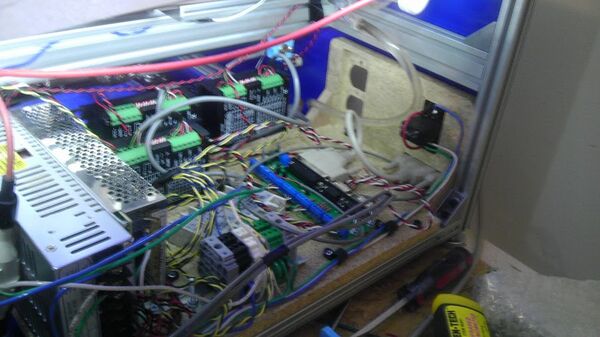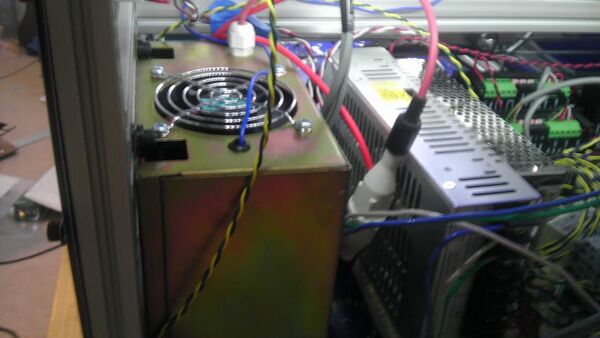Difference between revisions of "Laser Cutter"
Briancribbs (talk | contribs) |
|||
| Line 1: | Line 1: | ||
The laser cutter is a CNC(Computer Numeric Control) machine capable of the following: | |||
The laser cutter is a CNC (Computer Numeric Control) machine capable of the following | |||
* Cutting | * Cutting | ||
* paper | * paper | ||
| Line 38: | Line 8: | ||
* plywood of certain thicknesses depending on number of layers as well as what type of bonding glue was used | * plywood of certain thicknesses depending on number of layers as well as what type of bonding glue was used | ||
* other stuff I haven't yet tried | * other stuff I haven't yet tried | ||
* Engraving (vector | * Engraving (raster and vector) | ||
* cardboard | * cardboard | ||
* plastic | * plastic | ||
| Line 44: | Line 14: | ||
* glass | * glass | ||
* dark stone | * dark stone | ||
Contrary to popular belief lasers don't melt things. They remove material via a process called sublimation; turning an object from the solid state directly to the gaseous state skipping the liquid stage almost completely. | |||
The laser uses an RF excited CO2 gas laser producing an invisible to the human eye beam at 1090um. Almost everything is opaque to this wavelength and as such if it can sublimate the material it will. This means that if you put *anything* in the path of the laser it'll try to cut it. If it can't cut the material and it doesn't reflect the beam it *WILL* heat it up very very rapidly. The excited gas you can visually see in the tube is kind of the same thing you see in neon signs. 25KV is applied and the gas is excited to the point where it has to release extra electrons and you see this as light. Do not forget that the beam coming out of the tube is completely invisible and completely dangerous. | |||
In this picture from left to right you can see: | In this picture from left to right you can see: | ||
# 24VDC power supply; large aluminum case | # 24VDC power supply; large aluminum case | ||
| Line 73: | Line 27: | ||
# Power entry | # Power entry | ||
# Hole for 120VAC duplex outlet | # Hole for 120VAC duplex outlet | ||
[[File:laserStuff1.jpg]] | [[File:laserStuff1.jpg|thumb|600px]] | ||
In the second picture you can see the high voltage power supply | In the second picture you can see the high voltage power supply | ||
[[File:laserStuff2.jpg]] | [[File:laserStuff2.jpg|thumb|600px]] | ||
The gantry is driven by a single dual-shaft stepper motor. This motor has a driveshaft on either side that goes to a bearing mechanism attached to the Y rails. Nearest this bearing mechanism there is a timing belt pulley on the shaft. The belt rides on this pulley and connects to the gantry's carriage to pull it back and forth. All motion in the laser cutter is established via pulling as you can't push a belt. | The gantry is driven by a single dual-shaft stepper motor. This motor has a driveshaft on either side that goes to a bearing mechanism attached to the Y rails. Nearest this bearing mechanism there is a timing belt pulley on the shaft. The belt rides on this pulley and connects to the gantry's carriage to pull it back and forth. All motion in the laser cutter is established via pulling as you can't push a belt. | ||
Revision as of 00:27, 12 May 2013
The laser cutter is a CNC(Computer Numeric Control) machine capable of the following:
- Cutting
* paper * cardboard * plastics up to 1/2" depending on type * craft foam * plywood of certain thicknesses depending on number of layers as well as what type of bonding glue was used * other stuff I haven't yet tried
- Engraving (raster and vector)
* cardboard * plastic * wood * glass * dark stone
Contrary to popular belief lasers don't melt things. They remove material via a process called sublimation; turning an object from the solid state directly to the gaseous state skipping the liquid stage almost completely.
The laser uses an RF excited CO2 gas laser producing an invisible to the human eye beam at 1090um. Almost everything is opaque to this wavelength and as such if it can sublimate the material it will. This means that if you put *anything* in the path of the laser it'll try to cut it. If it can't cut the material and it doesn't reflect the beam it *WILL* heat it up very very rapidly. The excited gas you can visually see in the tube is kind of the same thing you see in neon signs. 25KV is applied and the gas is excited to the point where it has to release extra electrons and you see this as light. Do not forget that the beam coming out of the tube is completely invisible and completely dangerous.
In this picture from left to right you can see:
- 24VDC power supply; large aluminum case
- 12VDC power supply; small aluminum case
- In the back are 3 Keling stepper drivers; black aluminum cases with green wiring terminals
- In front of those are 2 120VAC solid state relays (not wired and currently not present in the enclosure); grey plastic cases
- Breakout board
- Power entry
- Hole for 120VAC duplex outlet
In the second picture you can see the high voltage power supply
The gantry is driven by a single dual-shaft stepper motor. This motor has a driveshaft on either side that goes to a bearing mechanism attached to the Y rails. Nearest this bearing mechanism there is a timing belt pulley on the shaft. The belt rides on this pulley and connects to the gantry's carriage to pull it back and forth. All motion in the laser cutter is established via pulling as you can't push a belt.

